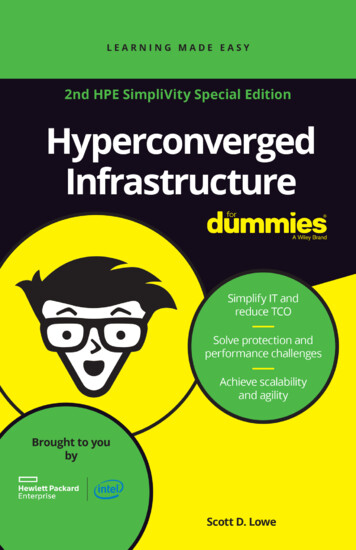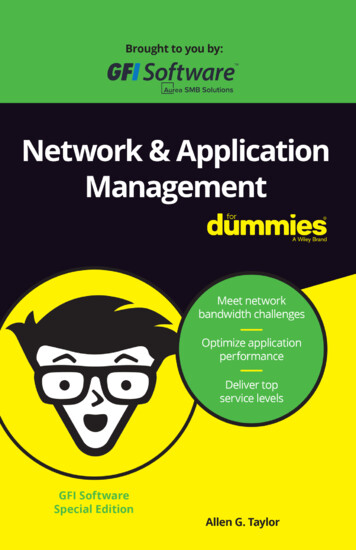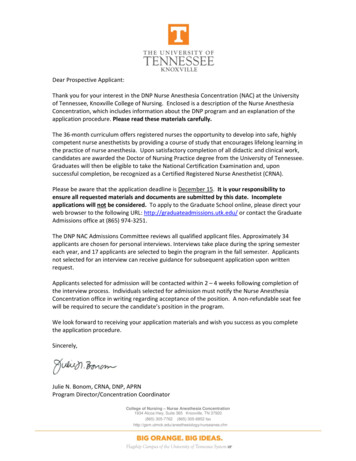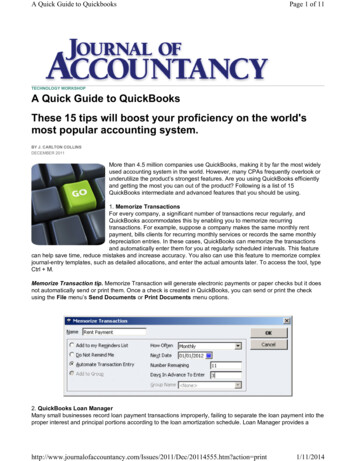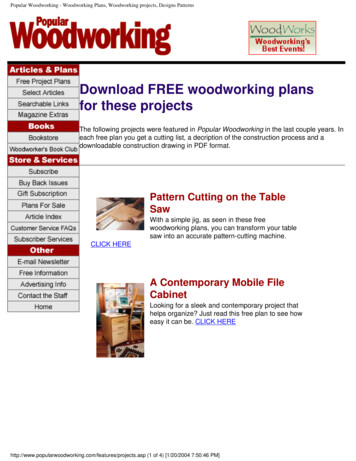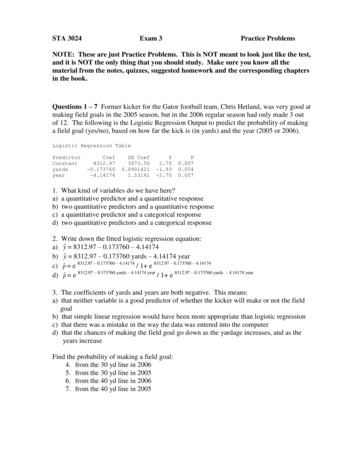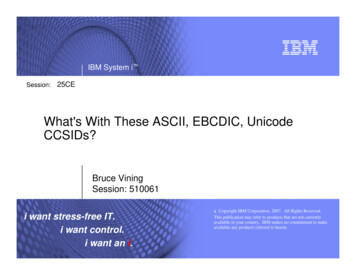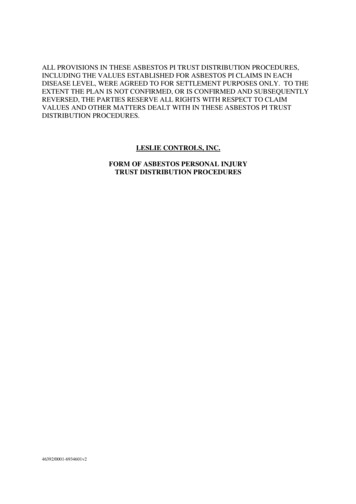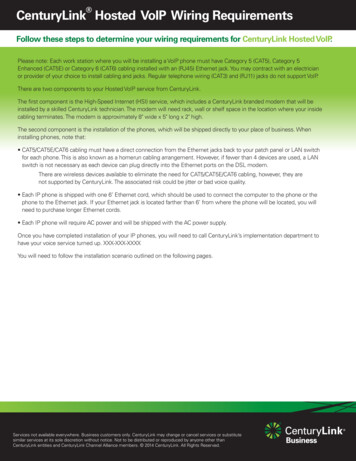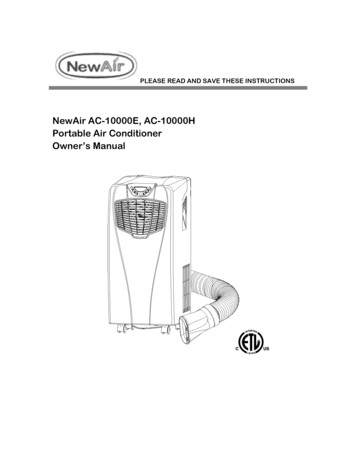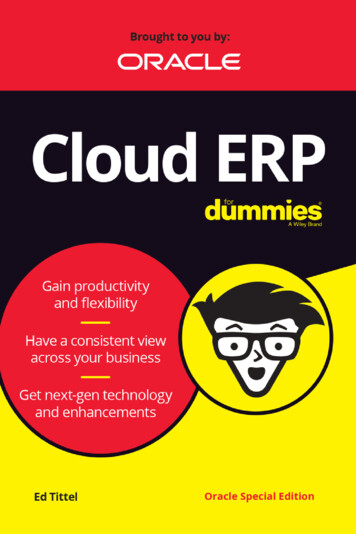
Transcription
These materials are 2022 John Wiley & Sons, Inc. Any dissemination, distribution, or unauthorized useis strictly prohibited.
Cloud ERPOracle Special Editionby Ed TittelThese materials are 2022 John Wiley & Sons, Inc. Any dissemination, distribution, or unauthorized useis strictly prohibited.
Cloud ERP For Dummies , Oracle Special EditionPublished byJohn Wiley & Sons, Inc.111 River St.Hoboken, NJ 07030-5774www.wiley.comCopyright 2022 by John Wiley & Sons, Inc., Hoboken, New JerseyNo part of this publication may be reproduced, stored in a retrieval system or transmittedin any form or by any means, electronic, mechanical, photocopying, recording, scanningor otherwise, except as permitted under Sections 107 or 108 of the 1976 United StatesCopyright Act, without the prior written permission of the Publisher. Requests to thePublisher for permission should be addressed to the Permissions Department, John Wiley& Sons, Inc., 111 River Street, Hoboken, NJ 07030, (201) 748-6011, fax (201) 748-6008, oronline at http://www.wiley.com/go/permissions.Trademarks: Wiley, For Dummies, the Dummies Man logo, The Dummies Way, Dummies.com, Making Everything Easier, and related trade dress are trademarks or registeredtrademarks of John Wiley & Sons, Inc. and/or its affiliates in the United States and othercountries, and may not be used without written permission. All other trademarks are theproperty of their respective owners. John Wiley & Sons, Inc., is not associated with anyproduct or vendor mentioned in this book.LIMIT OF LIABILITY/DISCLAIMER OF WARRANTY: WHILE THE PUBLISHER AND AUTHORS HAVEUSED THEIR BEST EFFORTS IN PREPARING THIS WORK, THEY MAKE NO REPRESENTATIONS ORWARRANTIES WITH RESPECT TO THE ACCURACY OR COMPLETENESS OF THE CONTENTS OF THIS WORKAND SPECIFICALLY DISCLAIM ALL WARRANTIES, INCLUDING WITHOUT LIMITATION ANY IMPLIEDWARRANTIES OF MERCHANTABILITY OR FITNESS FOR A PARTICULAR PURPOSE. NO WARRANTY MAY BECREATED OR EXTENDED BY SALES REPRESENTATIVES, WRITTEN SALES MATERIALS OR PROMOTIONALSTATEMENTS FOR THIS WORK. THE FACT THAT AN ORGANIZATION, WEBSITE, OR PRODUCT ISREFERRED TO IN THIS WORK AS A CITATION AND/OR POTENTIAL SOURCE OF FURTHER INFORMATIONDOES NOT MEAN THAT THE PUBLISHER AND AUTHORS ENDORSE THE INFORMATION OR SERVICES THEORGANIZATION, WEBSITE, OR PRODUCT MAY PROVIDE OR RECOMMENDATIONS IT MAY MAKE. THISWORK IS SOLD WITH THE UNDERSTANDING THAT THE PUBLISHER IS NOT ENGAGED IN RENDERINGPROFESSIONAL SERVICES. THE ADVICE AND STRATEGIES CONTAINED HEREIN MAY NOT BE SUITABLE FORYOUR SITUATION. YOU SHOULD CONSULT WITH A SPECIALIST WHERE APPROPRIATE. FURTHER, READERSSHOULD BE AWARE THAT WEBSITES LISTED IN THIS WORK MAY HAVE CHANGED OR DISAPPEAREDBETWEEN WHEN THIS WORK WAS WRITTEN AND WHEN IT IS READ. NEITHER THE PUBLISHER NORAUTHORS SHALL BE LIABLE FOR ANY LOSS OF PROFIT OR ANY OTHER COMMERCIAL DAMAGES,INCLUDING BUT NOT LIMITED TO SPECIAL, INCIDENTAL, CONSEQUENTIAL, OR OTHER DAMAGESISBN 978-1-119-79816-3 (pbk); ISBN 978-1-119-79819-4 (ebk)For general information on our other products and services, or how to create a custom ForDummies book for your business or organization, please contact our Business DevelopmentDepartment in the U.S. at 877-409-4177, contact info@dummies.biz, or visit www.wiley.com/go/custompub. For information about licensing the For Dummies brand for products orservices, contact BrandedRights&Licenses@Wiley.com.Publisher’s AcknowledgmentsSome of the people who helped bring this book to marketinclude the following:Project Editor: Elizabeth KuballAcquisitions Editor:Ashley CoffeyEditorial Manager: Rev MengleBusiness DevelopmentRepresentative: Will HullProduction Editor:Tamilmani VaradharajThese materials are 2022 John Wiley & Sons, Inc. Any dissemination, distribution, or unauthorized useis strictly prohibited.
Table of ContentsIntroduction. . . . . . . . . . . . . . . . . . . . . . . . . . . . . . . . . 1About This Book. . . . . . . . . . . . . . . . . . . . . . . . . . . . . . 1Foolish Assumptions. . . . . . . . . . . . . . . . . . . . . . . . . . 2Icons Used in This Book . . . . . . . . . . . . . . . . . . . . . . . 3Beyond the Book. . . . . . . . . . . . . . . . . . . . . . . . . . . . . 4CHAPTER 1:Defining ERP for Your Business. . . . . . . . . . . . 5Every ERP Solution Is Unique. . . . . . . . . . . . . . . . . . . 6Flexibility Is Key to Usable ERP. . . . . . . . . . . . . . . . . . 8How to Meet Your ERP Needs . . . . . . . . . . . . . . . . . 11Adapting ERP to Accommodate Change. . . . . . . . . 12CHAPTER 2:Mapping Your ERP Journey. . . . . . . . . . . . . . . 15The Legacy of ERP’s Origins . . . . . . . . . . . . . . . . . . . 16Moving into Modern ERP . . . . . . . . . . . . . . . . . . . . . 17Steps for Your Cloud Journey. . . . . . . . . . . . . . . . . . 20Ready for Compelling Events. . . . . . . . . . . . . . . . . . 24CHAPTER 3:Toward a Simpler, More Modern ERP. . . . . . 27Consolidating Multiple Systems. . . . . . . . . . . . . . . . 28Consolidation offers benefits. . . . . . . . . . . . . . . 28How consolidation works. . . . . . . . . . . . . . . . . . 30Getting to globalization. . . . . . . . . . . . . . . . . . . . 30About those benefits . . . . . . . . . . . . . . . . . . . . . 31Bringing Finance and HR Together. . . . . . . . . . . . . 32Connecting Your Supply Chain to Financeand Ops . . . . . . . . . . . . . . . . . . . . . . . . . . . . . . . . . . 35These materials are 2022 John Wiley & Sons, Inc. Any dissemination, distribution, or unauthorized useis strictly prohibited.
CHAPTER 4:Leveraging Next-Gen Technologies. . . . . . . . 39Automating Tasks and Processes . . . . . . . . . . . . . . 41Using Analytics and Personalized Data. . . . . . . . . . 44Using Mobile Tools for a Mobile Workforce. . . . . . 45Driving Insight and Innovation with ArtificialIntelligence. . . . . . . . . . . . . . . . . . . . . . . . . . . . . . . . 46Working with Chatbots and More. . . . . . . . . . . . . . 48CHAPTER 5:Forever Modern . . . . . . . . . . . . . . . . . . . . . . . . 49Focusing on Continuous Improvementand Innovation . . . . . . . . . . . . . . . . . . . . . . . . . . . . 50Keeping Up with Change. . . . . . . . . . . . . . . . . . . . . . 52Making Processes Modern. . . . . . . . . . . . . . . . . . . . 53Delivering New Features and Technology. . . . . . . 54CHAPTER 6:Ten Solid ERP Benefits. . . . . . . . . . . . . . . . . . . 57From Fragmentation to Single Source . . . . . . . . . . 57Other Benefits of Modern ERP. . . . . . . . . . . . . . . . . 58These materials are 2022 John Wiley & Sons, Inc. Any dissemination, distribution, or unauthorized useis strictly prohibited.
IntroductionERP is an acronym for enterprise resource planning(but it’s never sounded out, to avoid imitating rudenoises). More important, ERP describes a kind ofsoftware that organizations use to enable and support acompany’s business strategy. These include such functions as accounting, project management, procurement,risk management and compliance, and supply-chainoperations. In addition, a complete ERP software suiteincludes enterprise performance management softwareto help organizations plan, budget, predict, and report onfinancial results.About This BookERP systems are generally designed around a single,comprehensive, well-defined set of data structureswithin a common database. This approach ensures thatall data used across an enterprise is consistent, validated,and based on common definitions and shared userexperiences.Essentially, ERP defines a set of constructs for businessinformation so that business workflows work properlyand predictably across business departments. Primarily,ERP serves to enable, simplify, and standardize businessprocesses. This explains how finance, human resources,1These materials are 2022 John Wiley & Sons, Inc. Any dissemination, distribution, or unauthorized useis strictly prohibited.
engineering, IT, marketing, and operations can exchangevalid, compliant data, and how people and systems inthose departments can work together well. Simply put,ERP helps people collaborate and ties business processesand technologies together across their organization.One vital principle that informs ERP is central collectionof data for broad access and use. Instead of relying onmultiple databases and an outsize collection of disconnected spreadsheets, ERP systems bring order out ofchaos. With ERP at their beck and call, all employees —from the CEO to accounts payable staff — can create,store, and use data through a set of common processes,tools, and controls. Backed by a secure centralized datastore, all users can be sure that data is accurate, current,and complete. Data integrity automatically applies toevery ERP task, from quarterly financial statements orfilings to ad-hoc outstanding receivables reports. Noneed for disconnected, insecure, unprotected, and errorprone spreadsheets either!Foolish AssumptionsI made some basic assumptions about you, gentle reader,in writing this book:2These materials are 2022 John Wiley & Sons, Inc. Any dissemination, distribution, or unauthorized useis strictly prohibited.
»» I assume you know a fair amount about ERPsystems and software, especially how it providesuseful information to users and organizations.»» I assume you also know something about how ERPsystems are defined, set up, and managed.»» I assume you have a basic understanding of howERP software works and what kinds of problemsand issues your existing ERP software presents toyour organization.Icons Used in This BookOccasionally, special icons appear in the left margin.They call attention to important or noteworthy terms andtopics in the text. Here’s what you’ll find:The Remember icon points out informationworth recalling.The Tip icon flags something useful orhelpful by way of suggestion, advice, orobservation.3These materials are 2022 John Wiley & Sons, Inc. Any dissemination, distribution, or unauthorized useis strictly prohibited.
Beyond the BookThis book helps you discover more about choosing, working with, and using ERP software — especially modern,integrated end-to-end systems and platforms. For morematerial, try these resources:»» www.oracle.com/erp»» www.oracle.com/applications»» www.oracle.com/what-is-erp4These materials are 2022 John Wiley & Sons, Inc. Any dissemination, distribution, or unauthorized useis strictly prohibited.
IN THIS CHAPTER»» Capturing what’s unique foreach organization»» Understanding why flexibility iskey to ERP success»» Making sure your ERP needs aremet, today and tomorrowChapter1Defining ERP forYour BusinessEvery business or organization is different. Thatmeans that, although the kinds of data and businessprocesses that enterprise resource planning (ERP)must handle are somewhat alike, no two operations willever be identical.5These materials are 2022 John Wiley & Sons, Inc. Any dissemination, distribution, or unauthorized useis strictly prohibited.
Every ERP Solution Is UniqueThe basic characteristics that define modern ERP changeonly slowly. But the way that ERP systems get implemented — and especially the data that any ERPsystem stores and uses, along with controls that governhow that data is used, entered, validated, and so on —changes from implementation to implementation.ERP is the system, or collection of systems, that a business uses to manage its financials and other core businessactivities. Depending on how a business defines ERP foritself, this may involve one system; multiple integratedsystems; multiple, disjointed, and disconnected systems;or even spreadsheets. Organizations use ERP to collect,store, manage, report, and interpret data from their various business activities. Historically, ERP ran as on-sitesoftware. Today, ERP is increasingly cloud-based.The best ERP systems offer a comprehensive, continuously updated view of core business processes usingcommon databases. Thus, ERP systems track resourcesnecessary to conduct business — including cash, rawmaterials, and production capacity — along with thestate of business commitments such as orders, purchaseorders, invoices, payroll, and so forth.Many ERP systems share data across departments —including manufacturing, purchasing, sales, accounting,and more, along with corresponding checks and controls — to provide information and guidance on how6These materials are 2022 John Wiley & Sons, Inc. Any dissemination, distribution, or unauthorized useis strictly prohibited.
to conduct business. In fact, ERP acts as a conduit forbusiness information between and among organizationalunits. Then, too, ERP provides an important source forinformation to outsiders (partners, public and privateinvestors, venture capitalists, stockholders, and more) infeeding data into public, pro-forma reports and analysesand their private counterparts.TRACING ERP’STECHNOLOGY ROOTSERP traces its roots back to mainframe computing and inventory control packages in the 1960s.In the 1970s, wholesale adoption of DBMS toolsand technologies facilitated a move to materialsrequirements planning (MRP) systems. By thelate 1980s, MRP morphed into ERP through onpremises systems that enabled customizationfor specific business processes.In the 2000s, adoption of software as a service(SaaS)–oriented architectures saw ERP extendedto supply chains, expense management, and HRand compliance functions. In the 2010s, cloudcomputing functions ushered in a new ERP era.New digital technologies changed how usersinteracted with applications, including ERP.7These materials are 2022 John Wiley & Sons, Inc. Any dissemination, distribution, or unauthorized useis strictly prohibited.
For each organization, ERP must reflect specific workflows to make sure business processes work. Items andactivities tracked in a retail company differ from thosefor a heavy equipment manufacturer. ERP gains impactand value from its ability to handle the right mix of business capabilities that match the data and workflows inyour organization.Flexibility Is Key toUsable ERPToday, many companies run their businesses on a patchwork of finance and operations systems commonly calledERP that prevents them from adequately keeping up withconstantly changing market environments. This situation creates data silos, along with disconnected processesand user experiences that make it difficult to react tomarket shifts quickly. They might also compromise datasecurity. Indeed, flexibility is a key ingredient in ensuring that ERP provides the kind of accurate and timelyinformation that businesses need.ERP doesn’t have to be a high-maintenance patchworkresulting from years of customization and mergers andacquisitions (M&A). It doesn’t have to slow down thebusiness. New technologies such as machine learningand intelligent automation, as well as immersive user8These materials are 2022 John Wiley & Sons, Inc. Any dissemination, distribution, or unauthorized useis strictly prohibited.
experiences, make it more valuable and transformativefor companies to run their businesses on a new generation of ERP.Today’s technology-driven ERP enables businesses tobecome more agile and nimble and to keep pace withchange, stay ahead of problems, and take advantage oftrends and emerging opportunities. In fact, modern ERPfits very well into a philosophy of constant improvementand continuous innovation.The absolute requirement for modern ERP is timely datathat takes a unified view of the entire business. It letsbusiness leaders act on real-time insights to make effective and impactful decisions. The ability to act on insightsthrough support for highly automated and seamless processes means that a business can execute faster andspend more time growing and developing newopportunities.Here’s a list of signs that it’s time for modern,next-gen ERP:»» You’re stuck on an old version because upgradingheavily customized setups is costly and disruptive.»» Usability dissatisfaction is mounting, whilereporting remains difficult and incomplete.»» Aging and maintenance-heavy customizations don’tsync with business processes.9These materials are 2022 John Wiley & Sons, Inc. Any dissemination, distribution, or unauthorized useis strictly prohibited.
»» Maintenance costs for hardware and software keepincreasing.»» Disparate, disjointed systems provide incoherentor conflicting views of status and situation.»» Current business process may not be supported.Departments may rely on spreadsheets to trackand manage their work.»» Major business events — M&A, initial publicofferings, headquarters relocation, sharedservice initiatives, business model shifts, and newmanagement — all demand ERP changes.»» Organizations can’t keep up with changing risks,security threats, and regulatory mandates.»» Rapid, global company growth is hampered by theexisting ERP system.»» The entire hiring cycle impacts organizations,especially where ERP is concerned. The existing ERPguard is retiring, but retaining employees is hardwith aging systems. Recruiting new talent usinglast-century business systems is harder still.»» You need to invest in new hardware.»» You need to accommodate changes to yourbusiness model, shared service initiatives, or newmanagement.10These materials are 2022 John Wiley & Sons, Inc. Any dissemination, distribution, or unauthorized useis strictly prohibited.
How to Meet Your ERP NeedsBy examining drivers for ERP modernization you canevaluate your organization’s upgrade needs. Theserequire analysis of ongoing technology and generationalchanges in the business and how current capabilities mayhold things back. Three key inflection points guide thisanalysis:»» Operational efficiency: Does the current ERPsystem support operational goals? You may needto incorporate another ERP system after anacquisition, your own legacy system may needupgrading, a new subsidiary may be starting up, anew product or business model may be comingonline, or you may be moving to a shared servicesmodel. For any or all of these, operational efficiency is a must. That puts ERP modernization onthe table.»» Digital transformation: These days, usersdemand collaboration and ease of use not typicalin on-premises ERP. User expectations for ERP withsmartphone-like experiences reflect everydaydigital life. Users need a single source of truth forall operational functions, real-time analytics withrole-based dashboards, mobile access, and socialcollaboration tools. ERP must also be easy toupdate often. Projects can’t take years to finish.11These materials are 2022 John Wiley & Sons, Inc. Any dissemination, distribution, or unauthorized useis strictly prohibited.
»» Growth and compliance: Growth often meansglobal expansion, increased financial complexity,and regionalized accounting, reporting, andcompliance needs. Then, too, growth means anincrease in data, with all the issues involved insecuring, managing, analyzing, and using that data.Modeling opportunities and their impacts (including M&A, new markets, customer growth, andmore) require the right systems with processes inplace to support regulatory scrutiny.A modernization strategy must take these inflectionpoints into account and fit your organization’s culture,budget, needs, and timeline. Recognizing where yourcurrent system fails to support business objectives is thefirst step toward ERP modernization.Adapting ERP toAccommodate ChangeTo begin with, organizations can use modern ERP tomake more and better use of what’s already available tothem — the data and business processes they already useto handle everyday business functions. Given the flexibility, adaptability, and user-friendly nature of a modernERP environment, a good initial way to foment change inan organization is to do more of the same — except toperform better and faster.12These materials are 2022 John Wiley & Sons, Inc. Any dissemination, distribution, or unauthorized useis strictly prohibited.
Next, organizations can look to enhanced access andcapabilities that modern ERP systems bring to the table.For example, they can leverage user- and mobiledevice–friendly applications. Why not let a smartphonephoto of an invoice or receipt act as input to a paymentsystem or a reimbursement request, for example? Modern ERP systems make this kind of thing simple andstraightforward.Organizations can build on their employees’ currentskills and knowledge to extend their capabilities and provide faster, better service. If tech support or frontlineworkers can easily forward requests for changes in thelook, feel, and functions of common everyday applications, change can help boost productivity and improveuser experiences at the same time. Developers and managers know that those requests that keep popping up areprobably worth investigating, if not implementing, in theinterest of getting things done quickly, easily, and withless friction.In addition, a modern ERP system should enable andaccommodate business changes easily and quickly. A newpricing or discount strategy can’t affect the bottom lineuntil it plays into the next transaction that occurs. Modern ERP lets businesses translate new strategies andapproaches into actionable capabilities, so that they canpivot on a dime, and then pocket that same dime to boosttheir profitability. Lots of minor improvements add up,as does the ability to encourage and welcome change in atimely fashion.13These materials are 2022 John Wiley & Sons, Inc. Any dissemination, distribution, or unauthorized useis strictly prohibited.
In general, planning for change also helps make room forinnovation. By soliciting input and suggestions fromfrontline workers and customers, organizations showthemselves willing to listen and learn from those withreal-world, everyday experience. By implementingchanges based on such input, organizations make systems faster, easier to use, and more productive.Eventually, the benefits of flexibility and a changetolerant, supportive environment will set people’s creative juices flowing. Salespeople will naturally proposemore and better ways to sell things, while support staffwill do likewise for taking care of service after the sale.This phenomenon will pervade your whole organizationas people see what modern ERP can already do and startto understand that it can do interesting and valuablethings for them, too. Modern, capable data controls alsohelp organizations identify risks at their point of originand empower users to make better decisions.14These materials are 2022 John Wiley & Sons, Inc. Any dissemination, distribution, or unauthorized useis strictly prohibited.
IN THIS CHAPTER»» Surveying the ERP legacylandscape»» Moving up to modern ERP»» Choosing the rightmodernization path»» Dealing with compelling eventsthat may crop upChapter2Mapping Your ERPJourneyIf your organization needs to modernize its enterpriseresource planning (ERP) environment, you need tounderstand the elements involved in transitioningfrom the status quo to a new, modern approach. To getunderway, take a look at a typical legacy landscape fromwhich most organizations will depart, before ponderingwhat’s involved in moving forward into modernized ERP.15These materials are 2022 John Wiley & Sons, Inc. Any dissemination, distribution, or unauthorized useis strictly prohibited.
The Legacy of ERP’s OriginsIntroducedinthe1980s,theoriginalERP implementation — ERP 1.0 — involved on-premises ERPdeployment using extensive customization for businessprocesses. The world is both more complex and morecompetitive than when ERP first appeared on in-housemainframes. Today more than ever, finance and technology are interlinked, with growing volumes of data drivingcritical business decisions, as well as operations, reporting, and compliance.That said, the current ERP landscape is often a hodgepodge of discrete and disparate systems — many acquiredalong with mergers and acquisitions (M&As) and neverintegrated or aligned with other on-premises platformsand solutions. In addition, a surprising number of companies still rely on spreadsheets or manual analysis toanalyze and plan purchasing, handle project management, and drive key financial and compliance reports.These may not even be tied to ERP systems or otherdatabases.Organizations are often constrained by monolithic, nonconforming ERP systems. Recent business conditionsonly magnify the drawbacks of running on a patchworkof such ERP systems, along with various software as aservice (SaaS) point solutions, spreadsheets, and otherhomegrown tools and reporting.16These materials are 2022 John Wiley & Sons, Inc. Any dissemination, distribution, or unauthorized useis strictly prohibited.
Fragmented environments are subject to vexing limitations.For one thing they often create data silos that keep relatedbusiness processes separate and disjointed. Sometimes,manual reconciliation is the only way to create globalviews of data and status. This can lead to variable andunhappy experiences as users seek to overcome suchlimitations through sheer dint of effort and expose themselves to potential errors and fraud. On-premises solutions may be limited in the data they accommodate andin the access they provide to users. And finally, legacysystems are often difficult (or impossible) to automate,which keeps the burden of obtaining and managing dataand reports on users and administrators.The real problem is that legacy systems are both complexand fragile. They can’t accommodate changing businessconditions easily or readily, and they neither scale well tohandle growth nor adapt well to support innovation andnew capabilities.Moving into Modern ERPThe impetus to make such a move comes along with thedesire to improve operational efficiency, accomplish digital transformation, accommodate growth and innovation, and support a 21st-century mindset aroundeducation, experiences, and expectations. What then,does modern ERP bring to its adopters to justify makingsuch a move?17These materials are 2022 John Wiley & Sons, Inc. Any dissemination, distribution, or unauthorized useis strictly prohibited.
Key aspects of modern ERP systems address the leadingconcerns that organizations face when considering amove into the cloud. These seven aspects belong to twocategories: modern platform parameters and modernbusiness application design. Taken as a whole, theydefine standards for a modern ERP system and create afoundation for agility and growth.Here are the three modern platform components:»» Security: A “defense in depth” approach tosecuring data at every layer of the stack is neededto deliver maximum data protection. By usingsecure data isolation in the cloud stack, organizations reduce risk and enable faster data access andprocessing.»» Integration: ERP solutions must connect business,people, and processes. They must also connecteasily to other systems, whether those systems areon-premises or in the cloud. The best approach toensure compatibility and scalability is to choose aflexible solution that uses a common framework tointegrate easily with other systems.»» Configuration (as opposed to customization):Legacy ERP often incorporated nonstandard orspecific business practices as customizations. Overtime, these increase maintenance and upgradecosts and challenges. Cloud-based solutions built18These materials are 2022 John Wiley & Sons, Inc. Any dissemination, distribution, or unauthorized useis strictly prohibited.
around standards-based platforms supportpersonalization and configuration within the ERPapplication itself. This makes enhancements“upgrade-safe.”If your on-premises ERP customizationsrelate to workflows, integrations, and reporting, cloud-based ERP solutions will likelymeet your requirements, simplify futuremaintenance, and reduce total cost of ownership (TCO).Modern cloud applications can scale as your businessgrows. They also support new digital technologies tohandle your organization’s ERP needs. To that end,cloud-based ERP solutions should include these modernbusiness application design components:»» Completeness: Best practices get built in to supportstandardization and provide controls that reflect thebusiness strategy. This lowers costs, increases productivity, and empowers users. Even for incremental,piecemeal cloud transitions, access to a completecollection of best-practice business processes ensuresstandardization across the enterprise. It’s important toevaluate whether a cloud ERP vendor supports a fullapplication suite or whether integration with othercloud solutions are called for. It’s important to makesure integration between on-premises and cloud-basedapplications is feasible, workable, and sustainable.19These materials are 2022 John Wiley & Sons, Inc. Any dissemination, distribution, or unauthorized useis strictly prohibited.
»» Globalization: A customer (located anywhere) mayhave global needs. Does the ERP vendor supportand facilitate these needs? Local data centers maybe required to comply with data sovereignty andregulatory mandates. A complete cloud ERP systemshares enterprise data across operations, businessunits, and HQ.»» Insight-driven analysis: Cloud ERP solutions mustprovide secure, real-time data access for financials,cost analyses, profitability, cash flow, and more.This establishes a single source of truth acrossroles, reports, and analyses. It’s what makes timelydelivery of key performance indicators (KPIs) tofrontline managers possible. It also vastly simplifiesprocesses usually dependent on end-of-cycle closeoperations or separate data warehouse extracts.Steps for Your Cloud JourneyPlanning a modern ERP strategy starts with a deployment team. It should bring implementation partners andcloud provider staff together with internal business, IT,finance, and other experts. Include the following elements in any modernization strategy, regardless of market size and technology choices:20These materials are 2022 John Wiley & Sons, Inc. Any dissemination, distribution, or unauthorized useis strictly
Dummies book for your business or organization, please contact our Business Development Department in the U.S. at 877-409-4177, contact info@dummies.biz, or visit www.wiley. com/go/custompub. For information about licensing the For Dummies brand for products or services, contact BrandedR
